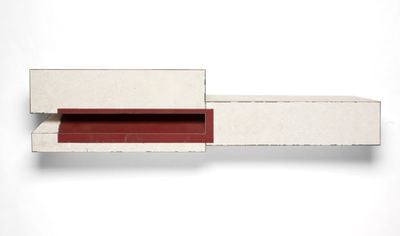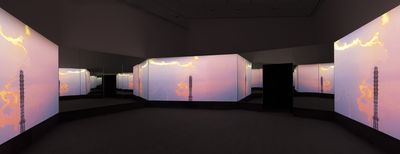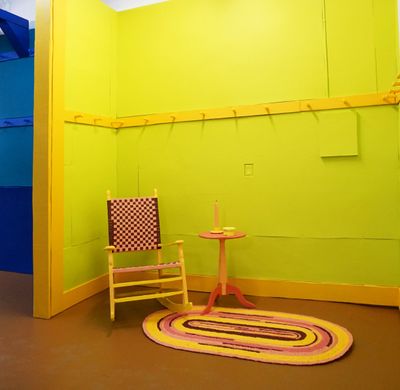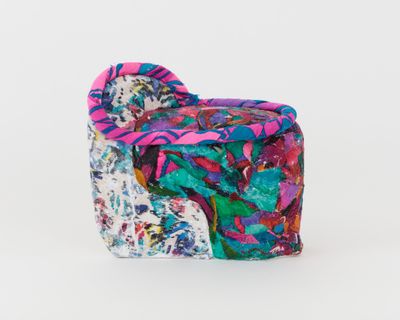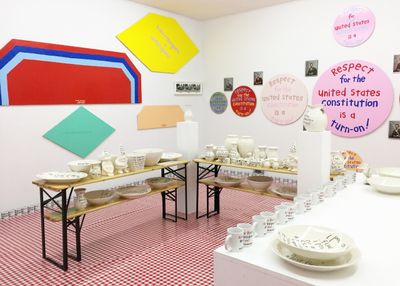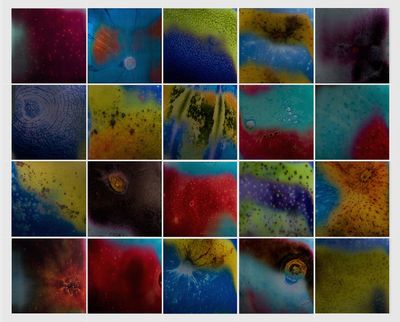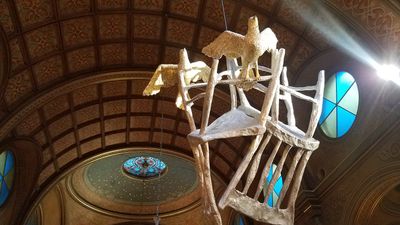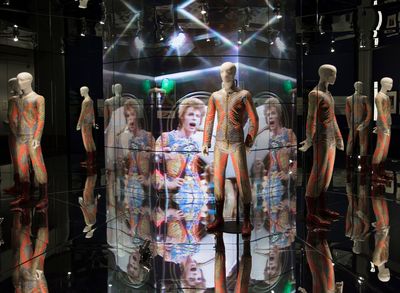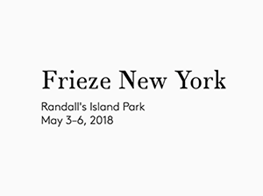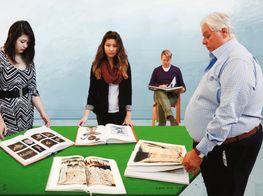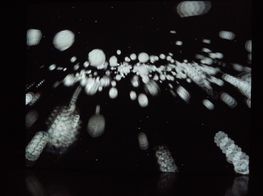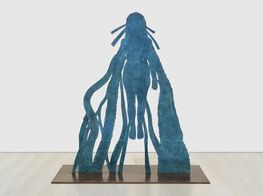2018 Lowdown: Shows to See during Frieze week

Installation view: David Hockney, Something New in Painting (and Photography) [and even Printing], Pace Gallery, 510 West 25th Street, New York (5 April–12 May 2018). Courtesy Pace Gallery. © 2018 David Hockney. Photo: Tom Barratt.
With Frieze New York returning to Randall's Island Park from 4 to 6 May 2018, Ocula is on hand to offer a selection of exhibitions around the city, from Bushwick and the LES to Chelsea, Midtown and the Upper East Side.
Before the Fall: German and Austrian Art of the 1930s
Neue Galerie, 1048 Fifth Ave, 86th Street
8 March–28 May 2018
It is more than a little worrying to realise how relevant this show seems in Trump's America, but when former secretary of state Madeleine Albright is moved to publish a book called Fascism: A Warning (2018) for example, you realise that the parallels that many commentators see between the 1930s and the present day are anything but far-fetched. The focus of this splendid and profoundly unsettling exhibition falls on the years when the Nazis gradually took control of Germany and Austria and the different ways in which artists navigated them.
Organised by Dr. Olaf Peters, University Professor at Martin-Luther-Universität Halle-Wittenberg, Before the Fall: German and Austrian Art of the 1930s is divided into sections including Landscapes and Still-life—anodyne titles that make it all the more unnerving when a creeping sense of anxiety enters the work as the years pass in this overview. The Landscapes section, for example, is dominated by paintings with dark, heavy skies and reaches a dreadful nadir in Richard Oelze's Expectation (1935–1936) in which a group of people, dressed as though they are just setting off for work, appear transfixed by the gloom that seems poised to envelop them.
There are both Nationalist Socialist posters in the show and political works—like A. Paul Weber's prints for Hitler: A German Doom (1931–1932)—that explicitly tackle Hitler's rise to power. However it is the work that falls between these two extremes, by artists who endeavoured to maintain their practice in a worsening social and political reality, which is most memorable here. In 1932, Wilhelm Traeger made a series of 41 linoleum cuts presenting 'vignettes of daily life' that he simply called Wien 1932/Vienna 1932. There are 22 of them included here. Disabled veterans of the Great War beg in the streets, wealthy gentlemen stroll with prostitutes on their arms, families who have lost their homes have their belongings carted away. In the harsh black on white contrasts of Traeger's prints, tragedy lurks everywhere.
Adrian Piper: A Synthesis of Intuitions, 1965–2016
Museum of Modern Art, 11 W 53rd St
31 March–22 July 2018
This enormous retrospective of the great conceptual artist Adrian Piper packs over 290 works into the museum's entire sixth floor and huge second-floor atrium. Almost unbelievably, this is Piper's first US museum exhibition in more than a decade and hopefully it will win her highly sophisticated art the appreciation of the broader public that it deserves. Piper has never confined herself to a single medium, and A Synthesis of Intuitions includes a dizzying selection of video, installation, performance, drawing, photography, painting, sculpture, and sound. If there is a central theme to Piper's wide-ranging endeavours, it is the questioning of social and political assumptions. Over the years she has engaged with questions of race, gender, xenophobia, and—with characteristic wit—the nature of social engagement.
Given that Piper has also repeatedly challenged assumptions around how work is exhibited, the exhibition's curatorial team—Christophe Cherix, MoMA's chief curator of drawings and prints, the department's former curator David Platzker and Connie Butler, chief curator at the Hammer Museum, Los Angeles, with MoMA curatorial assistant Tessa Ferreyros—should be congratulated for their attempts to embrace her decidedly anti-institutional work.
On Friday afternoons, look out for protesters outside the museum carrying signs reading EVERYTHING WILL BE TAKEN AWAY—what actually forms part of Piper's work Everything #3 (2003). If you choose to enter The Humming Room (2012) a sign explains that IN ORDER TO ENTER THE ROOM, YOU MUST HUM A TUNE. ANY TUNE WILL DO. Occupying the second-floor atrium, What It's Like What It Is #3 (1991), is a sound and video amphitheatre that manages to combine full-on racist stereotyping with the Commodores performing their 1977 groove, Zoom. One of the great strengths of Piper's work, and of this exhibition, is that it allows viewers to realise that personal politics can be both crucially important and genuinely entertaining.
Like Life: Sculpture, Colour, and the Body (1300–Now)
The Met Breuer, 945 Madison Ave
21 March–22 July 2018
The Met Breuer is probably the only art institution in New York that would even consider staging an exhibition with the subtitle 1300–Now. Constituting one of the Metropolitan Museum of Art's three locations—along with The Met Fifth Avenue and The Met Cloisters—The Met Breuer is holding an excellent show called Like Life: Sculpture, Colour, and the Body (1300–Now) that includes work from more than seven centuries of art history. At the show's core are attempts to make not just representations of the human form, but artefacts that might be mistaken for actual bodies. This is tricky territory: one of the exhibition's introductory wall panels notes that, 'for centuries, critics have condemned extreme feats of naturalism in sculpture as artless facsimile, humdrum entertainment, or even suggestive titillation,' and to their credit The Met Breuer's curators have brought together wonderful examples of all of these things.
There is an Auto Icon of Jeremy Bentham (1832): a lifelike, clothed facsimile of the philosopher that actually contains his skeleton. There is a Corpus with Movable Arms from the beginning of the 16th century: a figure of Christ that allowed worshippers to enact the Easter story with what is in effect, a huge bloody doll. There is Marc Quinn's infamous Self (1991), the cast of his head in ten pints of his own frozen blood, which is displayed opposite a Reliquary Bust of Saint Juliana (c. 1376) that supposedly contains a fragment of the saint's skull.
There are repeated reminders here of the creepier aspects the death cult that Christianity sometimes became. There are even creepier examples—ranging from El Greco (Pandora, 1600–1610) to Hans Bellmer (La Poupée, ca. 1936 and La Demi-Poupée, 1972) to John De Andrea (Self Portrait with Sculpture, 1980) of extreme realism used to sexualise the inanimate. The entire exhibition, which fills two whole floors of the Breuer building, has the undeniable character of a freak show, and that is one of the principal reasons why you should not miss it.
Something New in Painting (and Photography) [and even Printing]
Pace Gallery, 510 West 25th Street
5 April–12 May 2018
The version of Tate Britain's David Hockney show that came to the Metropolitan Museum of Art this winter—David Hockney (27 November–25 February 2018)—left many of Hockney's admirers frustrated that it did not include more of his more recent work, such as the figure paintings that he made when he returned to Los Angeles from his sojourn in East Yorkshire and which were shown in the exhibition Some New Painting (and Photography) at Pace Gallery in the winter of 2014/2015. Something New in Painting (and Photography) [and even Printing], Hockney's current exhibition at Pace Gallery, 510 West 25th Street, makes up for this—in fact a slightly different version of Something New in Painting (and Photography) [and even Printing] was originally scheduled to open in November to coincide with the Met retrospective.
Presented here are 17 large, mostly hexagonal acrylic paintings on canvas in which the venerable old man of British painting once again wrestles with a couple of his obsessions: landscape painting and pictorial perspective. His hexagonal format allows him to reverse traditional fixed vanishing point perspective, so that depicted space, whether his subject is the Grand Canyon or the terrace and garden of his Los Angeles home, seems to expand as it recedes from the viewer. Hockney takes another approach to how space is depicted and perceived in the couple of enormous photographic pieces that are also included here. In the Studio, December 2017 (2017) and Inside It Opens Up As Well (2018) present images of the paintings that make up the rest of Something New in Painting (and Photography) [and even Printing] with Hockney and his guests in an imaginary and oddly indeterminate studio space.
Ted Larsen: Working Vacation
Margaret Thatcher Projects, 539 West 23rd Street
12 April–12 May 2018
Though it would be hard to imagine contemporary art more different from Hockney's, Ted Larsen's new 'sculpted paintings' in his show Working Vacation at Margaret Thatcher Projects are marked by a similar wit and intelligence. Whereas Hockney works with traditional pictorial issues in paint on canvas, Larsen forages fragments of discarded objects and scrap materials, and makes small geometrical pieces.
In Tense Calm (2018), for example, materials from industrial and commercial contexts, like salvaged steel, veneered plywood, and rubber—which all bear the evidence of their previous use and thus suggestions of their status outside of art—are assembled into a wall sculpture only nine inches high. Like other pieces in this show, the work is at once minimalist and complex; both ironic and beautiful. These paradoxes are extended in the seemingly self-contradictory titles Larsen gives his works, like Baby Giant (2018) and Dull Roar (2018), and even the title he has given this exhibition.
Doug Aitken: New Era
303 Gallery, 555 West 21st Street
13 April–25 May 2018
Doug Aitken's immersive new video installation, New Era (2018), constitutes a three-dimensional screen via the construction of a disorienting hexagonal space built inside the gallery, where three projectors are pointed at three mirrored walls. The result is the kaleidescopic projection of a film that explores the impacts of cellular phone technology on the human condition—a 'liquid environment' in which image, sound and narrative collapse and reform to tell the story of our technological present. In focus is 89-year-old Martin Cooper, who invented the first cell phone in 1973. In the film, Cooper talks about his invention and what future he can see for it. From this, New Era connects the impact of the mobile phone's invention and the subsequent technologies that have developed around it with Cooper's life, resulting in the gradual expansion of the work as a portrayal of a coming future in which the singularity has become a reality.
Adding to this exploration into what a totally connected world might look like in the 21st century, when technology and the natural world coexist, is a second work, located at the end of a corridor that is dark save for a flickering light: a neon object that spells out its title—Jungle (2017)—in various formulations.
Sculpture 56
11 participating galleries, 56 Bogart Street
13 April–27 May 2018
Getting around the Brooklyn gallery scene can mean a lot of time on the bus or subway, but fortunately for visitors over Frieze weekend, 11 of the galleries at 56 Bogart Street in Bushwick are collaborating on Sculpture 56, a six-week contemporary sculpture project, meaning that you will be able to spend more time looking at art and less time travelling to seek it out.
Robert Henry Contemporary is showing Noah Loesberg and Melissa Vandenberg. Loesberg's show is called Remote Barrier Storage (13 April–25 May 2018) and features one of Loesberg's recurrent subjects: concrete traffic barriers, which the artist remakes in wood and depicts in oil stick and wax on paper. Vandenberg, who calls her work 'satirical and idealistic', presents Monument (13 April–25 May 2018). The show includes Outland (2017) a simplified image of the Stars and Stripes burned into the surface of paper with sparklers, and Untitled Gravestone (2012) an obelisk rendered flaccid by remaking it in linen and polyester.
At Fresh Window, Diana Sirianni tests the limits of what sculpture is with an installation titled Small Dance or the Space of my Body (2018), on view until 27 May 2018. She has filled the gallery with a collage of photographic prints and other materials such as thread, nylon, and pigments that are attached to the ceiling, hang from the walls, or lie on the floor. The prints frequently depict the artist herself in combination with photographic fragments—at times enlarged or reduced in scale—of works-in-progress, illegal public paste-ups that she has made in Berlin and Rome, and her past exhibitions in museums (she showed at ZKU in Berlin in 2017 and at the Städtische Galerie in Delmenhorst in 2016, for example).
At VICTORI + MO, Amie Cunat's Meetinghouse (2018) is a psychedelic multi-room installation that is quite a shock to the system. Throughout this interior, the artist has re-imagined a series of historical artifacts used by the Shakers—the radical religious sect that flourished in the United States in the 19th century and perfected a distinctive design style that was remarkable for its simple elegance.
Jennifer Paige Cohen: Lately Like a Hummingbird
Nicelle Beauchene Gallery, 327 Broome Street
20 April–20 May 2018
Jennifer Paige Cohen is a Brooklyn-based artist who has developed a strikingly personal body of sculpture that combines the brightly coloured fabrics of hand-me-down clothing with cast and modelled plaster. Cohen joined the gallery in 2013, and staged her first solo show there in 2014: Feels Like Telepathy showcased sculptures formed from the plaster impressions of isolated body parts, from a shoulder to a knee—either the artist's own or those of her friends—with fragments of clothing offering colour, texture and a trace of the personal in each plaster cast.
This new exhibition builds on Cohen's practice by presenting a series of small freestanding pieces cast from the artist's own body, with stronger accents created by a more dominant presence of the second-hand clothing that she integrates into her forms, with brighter colours and bolder patterns visible as they twist and collage into the material. Also presented are several new works: wall-hanging pieces made from encasing sweatshirts in plaster, their shape reminiscent of breastplates, and their surfaces adorned by fabric collage.
Cary Leibowitz: I Need To Grow Up And Be Taken Seriously Said The Clown At the Urinal
Invisible-Exports, 89 Eldridge Street
29 March–13 May 2018
Cary Leibowitz is remarkable not merely for his irreverent and thought provoking humour, but for the fact that it has underpinned his work for so long without becoming stale or predictable. In the 1990s, Leibowitz operated under the pseudonym Candyass, which Hilton Als called a 'means of deflecting criticism', behind which Leibowitz styled himself as 'a poster child of the über-popular burp variously deemed "Pathetic Aesthetic," "Abject Art," and "Loser Art",' to quote Jerry Saltz. The artist's interdisciplinary practice is hinged on the prospect and realities of failure in mass consumer culture, connecting this with the equally pathetic opportunities that an artist like Leibowitz felt he had in the arena of contemporary art. The result is a body of work that uncovers the anxieties, neuroses, and bitter complexes that quiver beneath formal, idealised surfaces—paintings that mimic those of the neo-expressionists or hard-edge minimalists, but with text written on their monochromatic surfaces, such as: 'Modern Art Sucks. You're Fat.'
Invisible-Exports describes Leibowitz as 'the New York art world's master painter of abjection and neurosis, self-loathing, self-doubt, and self-interrogation'. His new show at the space is enormously entertaining precisely for that reason. I Need To Grow Up And Be Taken Seriously Said The Clown At the Urinal includes new ceramics, text paintings, and Americana photo collages. A number of these, including the text painting Joan Collins has a Headache (2018) relate to the actress Joan Collins, whose old desk Leibowitz bought at auction in 2016.
Jitish Kallat: Decimal Point
Sperone Westwater, 257 Bowery
26 April–16 June 2018
Jitish Kallat's exhibition Decimal Point is described as 'a culmination of several strands of inquiry developed over the last few years', bringing together themes that the artist has long explored in his multi-disciplinary practice, which includes the artist's role as artistic director of the 2014 Kochi-Muziris Biennale. These include investigations into how matter, time and perception might be represented in ways that encapsulate both micro and macro phenomena related to each concept. Central to the show are the photographic works from the 'Sightings' (2017–2018) series: lenticular prints that look like images of celestial events caught up close, that are in fact zoomed in shots of various fruits, their colours inverted to mirror the cosmic pictures to which they have been associated.
Continuing the cosmological thread are works on paper from the 'Wind Study–Hilbert Curve' (2017) series, which are based on the continuous, fractal, and self-similar space-filling curves first described by the German mathematician David Hilbert in 1891. Kallat uses Hilbert's infinite dimensional space as a diagrammtic template on which he creates what he calls 'transcripts derived by eavesdropping on the silent conversation between wind and fire'—on paper, he recreates portions of 'Hilbert's Space', and sets each line on fire, allowing the elements to direct the marks left on the surface. Related to this work is Rain Study (the hour of the day of the month of the season) (2017), for which Kallat held drawing paper under the rain, sprayed pigment on the resulting marks before wiping each sheet dry, creating a representation that, like 'Sightings', recalls the galaxies and constellations that fill the night sky.
Kiki Smith: Below the Horizon
Museum at Eldridge Street, 12 Eldridge Street
12 April–10 October 2018
While on the Lower East Side, do not miss Kiki Smith's site-specific exhibition Below the Horizon at the Museum at Eldridge Street. A National Historic Landmark, the synagogue is worth a visit in itself: built in 1887, it is the first house of worship constructed in America by Eastern European Jews fleeing Europe during a period of mass migration in the late 19th and early 20th centuries. Today, the Synagogue describes itself as 'the only remaining marker of the old Jewish Lower East Side that is open to the public.'
In 2010, Kiki Smith worked with architect Deborah Gans to install a remarkable stained-glass window that replaced the synagogue's eastern window, marking the final significant component of what was a 20-year restoration. Now she has returned to install 50 works ranging from painting to sculpture to print relating to the building's history, including the decades up to the mid-1950s, when its congregation could not afford to keep its main sanctuary open. A number of the pieces that Smith has installed feature images of stars, a motif that is key to her stained-glass window, and the exhibition's title refers to night, when the sun disappears below the horizon.
David Bowie is
Brooklyn Museum, 200 Eastern Pkwy
2 March–15 July 2018
For an entirely different experience, and if you haven't yet seen it on its five-year, twelve-museum world tour that started in London in 2013 at the Victoria and Albert Museum, which organised the show, the Brooklyn Museum is currently hosting David Bowie is. This remarkable interactive experience celebrates one of the more important cultural figures of the last 50 years, with some 400 objects on view, mostly sourced from the David Bowie Archive. These include Bowie's costumes such as those designed by Freddie Burretti for Ziggy Stardust / 1980 Floor Show and Kansai Yamamoto for the Aladdin Sane tour, 85 hand-written lyric sheets, around 40 music videos, television clips and film scenes, plus Bowie's oil paintings, including two of Iggy Pop.
Equally impressive is the technical tour de force that is this exhibition's staging. Every visitor to the show is handed a pair of headphones that allows them to hear a sequence of musical and verbal accompaniments to what they are looking at. As they move from one object, photograph, or projection screen to the next, the appropriate music travels with them, perfectly synced. You will need to buy a timed ticket to enter, and even so it gets pretty crowded in there, but if you are looking for a total change of pace from Frieze, this might be the destination for you. —[O]


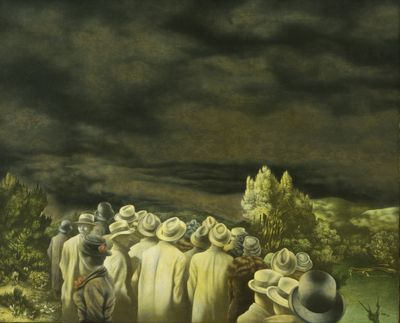
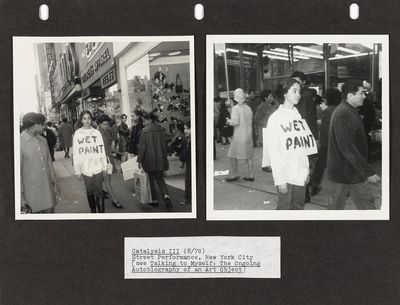

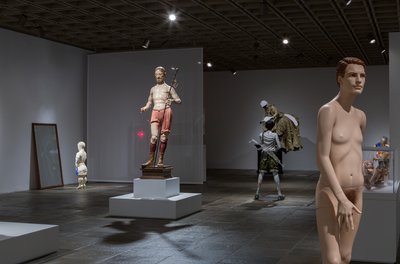
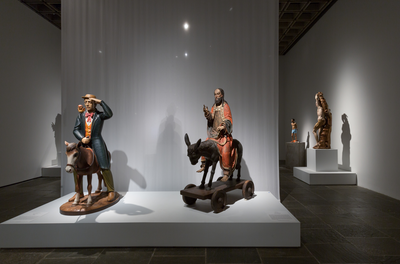
![Exhibition view: David Hockney, Something New in Painting (and Photography) [and even Printing], Pace Gallery, 510 West 25th Street, New York (5 April–12 May 2018).](https://files.ocula.com/anzax/Content/Reports%2FFrieze%20NY%20Lowdown%2FHockneyinst2018vE_400_0.jpg)
![Exhibition view: David Hockney, Something New in Painting (and Photography) [and even Printing], Pace Gallery, 510 West 25th Street, New York (5 April–12 May 2018).](https://files.ocula.com/anzax/Content/Reports%2FFrieze%20NY%20Lowdown%2FHockneyinst2018vG_400_0.jpg)
